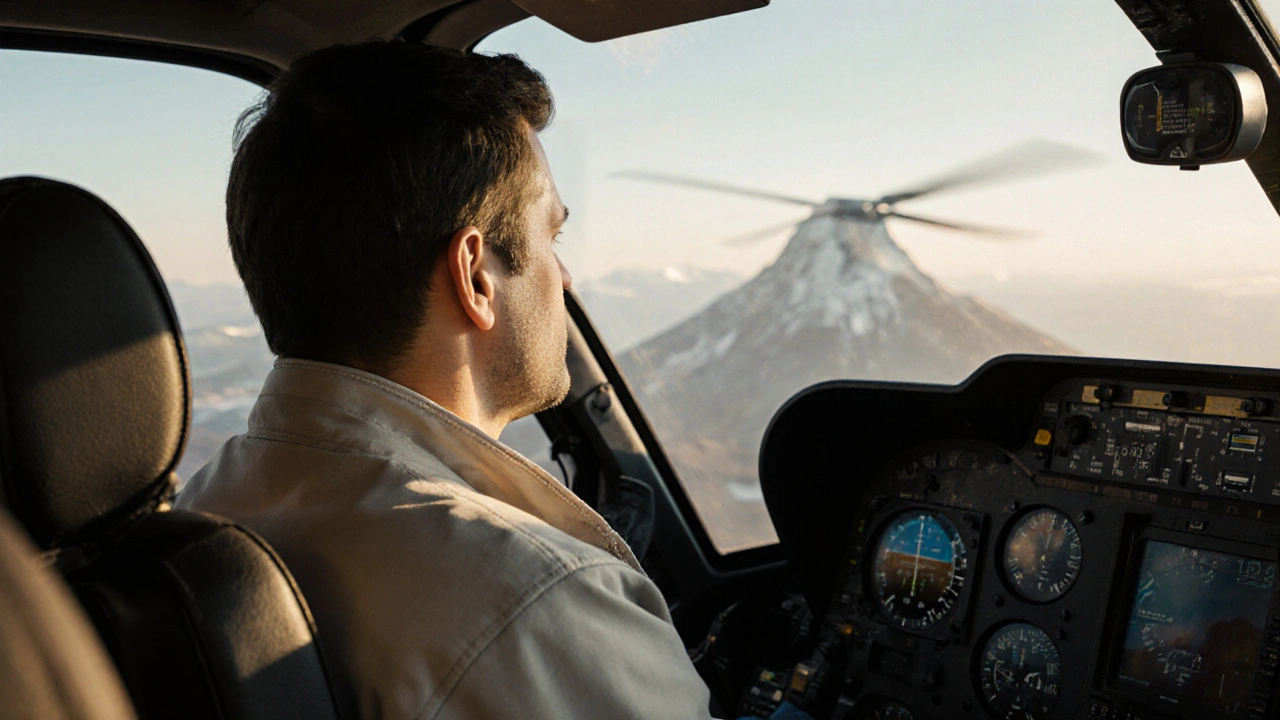Helicopter Motion Sickness Prevention Guide
Your Personalized Prevention Plan
Quick Takeaways
- Stay hydrated and eat a light, bland snack before the flight.
- Focus on a fixed point on the horizon or use an acupressure wristband.
- Try ginger tea, deep‑breathing exercises, or a prescribed anti‑nausea medication.
- Choose a seat over the rotor mast where motion feels less intense.
- If symptoms persist, seek medical advice - persistent dizziness can signal an underlying condition.
Why Helicopter Motion Triggers Dizziness and motion sickness
Helicopters generate a unique mix of vertical lift, pitch, roll, and yaw. Unlike fixed‑wing aircraft, they can hover, change direction rapidly, and experience sudden turbulence. This creates an inconsistent flow of sensory cues that confuses the brain.
When your vestibular system is a network of inner‑ear structures that detects balance and motion receives signals that don’t match what your eyes see, the mismatch triggers nausea, sweating, and the sensation of dizziness lightheadedness or unsteadiness. This is essentially the classic definition of motion sickness, only amplified by the helicopter’s erratic movements.
Immediate In‑flight Strategies
Once you notice the early signs-cold sweats, a queasy stomach, or a spinning head-act quickly. The goal is to restore harmony between visual, vestibular, and proprioceptive inputs.
- Visual fixation: Look straight ahead at a distant, stable object (the horizon, a tower, or the cockpit window). Avoid scanning the interior or reading screens.
- Seat selection: If possible, sit near the rotor mast or over the helicopter’s center of gravity; motion feels smoother there.
- Acupressure wristband: These bands apply pressure to the P6 (Neiguan) point. Studies show a 30% reduction in nausea for many travelers.
- Controlled breathing: Inhale through the nose for four seconds, hold for two, then exhale slowly through the mouth for six seconds. This calms the autonomic nervous system.
- Hydration: Sip cool water or an electrolyte solution. Dehydration worsens vertigo and can accelerate nausea.
Pre‑flight Preparations
Prep work the night before and the morning of the flight can dramatically lower the odds of getting sick.
- Diet: Eat a light, low‑fat meal-think toast, banana, or oatmeal. Avoid heavy, greasy foods and alcohol.
- Ginger intake: Ginger a root known for anti‑nausea properties can be taken as tea, capsules, or candied slices. A 1‑gram dose has been shown to cut nausea intensity by up to 40%.
- Medication planning: Over‑the‑counter options like meclizine an antihistamine that reduces vestibular stimulation work best when taken 30‑60 minutes before departure. Prescription alternatives (e.g., scopolamine patches) should be discussed with a doctor.
- Rest: Aim for at least 7-8 hours of sleep. Fatigue amplifies vestibular sensitivity.
- Clothing: Wear comfortable, loose‑fitting garments. Tight collars can restrict breathing and increase discomfort.

Medication and Supplement Options
When natural tricks aren’t enough, medication can provide reliable relief. Below is a quick comparison of the most common choices.
| Remedy | Type | Onset | Duration | Typical Side Effects |
|---|---|---|---|---|
| Meclizine OTC antihistamine | Pill | 30‑60 min | 24 hrs | Drowsiness, dry mouth |
| Scopolamine patch Prescription transdermal patch | Patch | 4‑6 hrs | 72 hrs | Blurred vision, mild confusion |
| Ginger Natural root | Tea / capsule | 15‑30 min | 2‑3 hrs | Heartburn (rare) |
| Acupressure wristband Band applying pressure to P6 point | Wearable | Instant | While worn | Skin irritation (rare) |
Choose a remedy that matches your flight length, medical history, and personal tolerance. For short hops (under 30 minutes), ginger or a wristband often suffices. For longer tours exceeding an hour, a meclizine tablet or a scopolamine patch-prescribed after a doctor’s review-offers steadier protection.
Long‑term Strategies for Sensitive Travelers
If you frequently fly in helicopters-whether for tourism, work, or medical transport-consider building resilience over time.
- Habituation training: Gradually increase exposure. Start with a short, low‑altitude ride, then extend duration and altitude as tolerance builds.
- Vestibular therapy: Physical therapists can guide exercises that strengthen balance and reduce sensitivity.
- Regular exercise: Aerobic activities improve circulation and oxygen delivery to the inner ear, helping the vestibular system function smoothly.
- Stress management: Anxiety amplifies sensation of motion. Mindfulness, meditation, or short pre‑flight counseling can calm nerves.
When to Seek Professional Help
Occasional nausea is normal, but persistent dizziness may indicate an underlying issue such as vestibular migraine, inner‑ear infection, or cardiovascular problems. Contact a healthcare provider if you notice:
- Symptoms lasting more than 24 hours after the flight.
- Recurring episodes even without travel.
- Hearing loss, ringing in the ears, or severe headache.
- Fainting, chest pain, or shortness of breath.
Early diagnosis can prevent complications and give you targeted treatment options.
Recap of Key Actions
Before you board, hydrate, snack lightly, and consider ginger or an OTC antihistamine. During the ride, fix your gaze, breathe slowly, and use an acupressure band if you have one. After landing, continue sipping water and monitor how you feel. Adjust your strategy based on flight length and personal response.
Frequently Asked Questions
Can I take motion‑sickness medication if I have allergies?
Most OTC options like meclizine are antihistamines, so if you are allergic to similar drugs, consult a doctor. Alternatives such as ginger or acupressure have no drug interactions.
How far in advance should I apply a scopolamine patch?
Apply the patch to a clean, dry area of skin 4‑6 hours before the flight. The medication starts working gradually and can last up to three days.
Is ginger effective for everyone?
Most people experience relief, but the effect varies. If you have gallstones or blood‑thinning medication, talk to a clinician before using large amounts.
What seat location reduces motion the most?
Seats over the helicopter’s center of gravity-usually near the rotor mast-experience less pitch and roll, making them the most stable positions.
Should I avoid coffee before a helicopter ride?
Caffeine can increase heart rate and may worsen anxiety‑related nausea. A small amount is fine, but it’s safer to stick with water or a mild herbal tea.


janvi patel
October 1, 2025 AT 22:34I think the whole ginger hype is just overblown.
Lynn Kline
October 7, 2025 AT 16:34Wow, this guide is like a burst of sunshine for anyone battling those dizzy spirals on a chopper!!! 🌟 Grab that ginger, strap in those acupressure bands, and ride the skies like a champ!!!
Rin Jan
October 13, 2025 AT 10:34Honestly, the real problem isn’t the lack of ginger or a patch, it’s the mindset we bring into the cabin. When you think the helicopter is a moving coffin you’ll feel sick no matter what you take. The body listens to anxiety before any medicine can act. I’ve seen people pop pills and still vomit because they’re terrified of the rotor wash. So the first step is to calm the inner dialog. Visualize a smooth flight and breathe deeply. Practice mindfulness before boarding. A calm mind reduces the vestibular overload. Also, stay hydrated but avoid heavy meals beforehand. Light snacks like crackers are ideal. If you’re prone to motion sickness, sit facing forward and keep your eyes on a fixed point. The horizon works wonders. Lastly, respect your body’s signals and don’t push yourself if you feel nauseous. It’s better to skip a ride than to end up on the ground feeling worse. Remember, prevention is a holistic approach, not just a pill.
Jessica Taranto
October 19, 2025 AT 04:34Thanks for the practical steps! I love how you highlighted the importance of mindset, staying hydrated, and picking the right seat. Those details really help beginners feel prepared.
akash chaudhary
October 24, 2025 AT 22:34Let me break this down: the guide assumes everyone has the same tolerance for motion, which is plain wrong. You cannot treat complex vestibular responses with a one‑size‑fits‑all patch. Moreover, the script is riddled with vague recommendations and ignores contraindications for certain meds. A truly useful guide would list dosage limits, drug interactions, and when to consult a physician. As it stands, it’s oversimplified and potentially dangerous for at‑risk users.
Adele Joablife
October 30, 2025 AT 15:34This is a solid overview, but I’d caution readers to test any remedy on a short flight first. Not every natural option works for everyone.
kenneth strachan
November 5, 2025 AT 09:34Okay, I’m gonna be real, this guide sounds like every other “just take ginger” article lol. Like, sure, ginger’s great but it won’t magically stop you from feeling like a seasick hamster on a spinny ride.
Mandy Mehalko
November 11, 2025 AT 03:34Great tips! I’ve tried ginger tea and it really helped me stay calm during my last tour flight. Keep spreading the good vibes!
Bryan Kopp
November 16, 2025 AT 21:34Just stick to the basics and you’ll be fine.
Patrick Vande Ven
November 22, 2025 AT 15:34From a clinical perspective, the most effective prophylaxis combines a low‑dose antihistamine taken one hour before flight with vestibular habituation exercises practiced regularly. This protocol has been validated in peer‑reviewed studies and minimizes sedative side effects.
Tim Giles
November 28, 2025 AT 09:34In reviewing the literature, it becomes evident that motion sickness susceptibility is influenced by a confluence of factors including vestibular sensitivity, visual-vestibular mismatch, and autonomic nervous system reactivity. Consequently, a multifaceted approach that incorporates pharmacological agents such as meclizine, behavioral techniques like controlled breathing, and environmental modifications-such as seating orientation and minimizing visual distractions-offers the most robust protection. It is advisable to conduct a pre‑flight assessment to tailor the intervention to the individual’s risk profile.
Peter Jones
December 4, 2025 AT 03:34I appreciate the thoroughness here. Let’s all support each other by sharing what works and staying safe up there.
Gerard Parker
December 9, 2025 AT 21:34Here’s the bottom line: if you’re going to fly, take a proven anti‑emetic like scopolamine patch at least four hours before take‑off, combine it with ginger for gut comfort, and keep your head stable with a supportive pillow. Don’t be lazy-read the instructions, respect the dosage, and you’ll avoid the drama of a mid‑air puke.
Thomas Burke
December 15, 2025 AT 15:34Got it! Remember to hydrate, test a small dose of ginger, and keep your eyes on a steady point. You’ve got this.
Debbie Frapp
December 21, 2025 AT 09:34Awesome guide! I love how it balances natural remedies with medical options. Thanks for sharing such a clear, helpful resource.